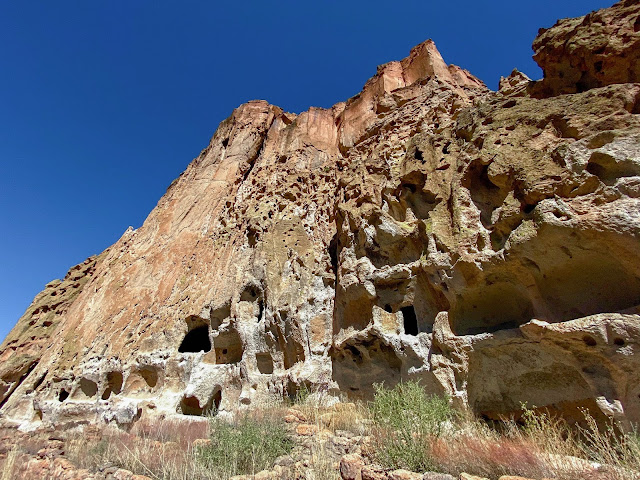The next day, we said goodbye to Albuquerque and began the long drive to Taos. We made several stops along the way to break up the drive, our first and main stop of the day was at Bandelier National Monument.
Bandelier National Monument protects over 33,000 acres of rugged but beautiful canyon and mesa country, with evidence of people having lived here for more than 11,000 years. Petroglyphs, dwellings carved into the soft rock cliffs, and masonry pueblos (villages) are evidence of the Ancestral Pueblo people whose descendants still live nearby.
There is a 1.2 mile Main Trail Loop that gives easy access to a number of ancestral pueblo homes, kivas (ceremonial structures), rock paintings, and petroglyphs.
A kiva is a room used by Puebloans for rites and political meetings, many of them associated with the kachina belief system. Among the modern Hopi and most other Pueblo people, kivas are a large room that is circular and underground, and are used for spiritual ceremonies.
Visitors are allowed to climb some of the ladders and get a view of the inside of a few of the stone dwellings. There were usually long lines of people waiting to climb the ladders and we were on a tight time schedule, so we didn't look inside any of the dwellings.

There are several examples of petroglyphs along the stone walls. They were rather faint, so you had to make sure to really keep an eye out to really see them.
Back at the Bandelier gift shop, I saw this magnet, and as someone who has created a career out of being gentle, I really appreciated this proverb.
After our time at Bandelier, we drove for a little while longer then made a stop for lunch at Rancho De Chimayo. This was one of my favorite lunch stops of the entire tour. The restaurant was so adorable and all decorated for fall and the food was fresh, homemade New Mexican food with the best signature appetizer and dessert!
Rancho De Chimayo is housed in a 100-year-old adobe home, that has been restored by the Jaramillo family into this award winning restaurant. It is still family owned and operated and is a treasured part of New Mexico’s heritage and history.
We began our meal with an appetizer of sopaipillas, light, crispy pastry puffs, with honey for dipping. They were warm and so delicious.
For my entree I got tamales with red and green sauce. The unofficial state question of New Mexico is red or green? Since everything is served with chile sauce. If you want both, you can just say Christmas. I loved this little tidbit of New Mexican culture.
For dessert, we all got Natillas. Natillas is a term used to refer different delicacies in the Spanish-speaking world. In Spain, this term refers to a custard dish made with milk and eggs. The version we got here is a soft custard, covered with crema dulce batida, with some powdered cinnamon on top.
This was such a perfect dessert, it wasn't too sweet, but was cool and creamy, the perfect way to end a delicious meal.
After lunch, we drove a little more, we were about 50 miles away from Taos at this point. We made a couple of more stops before driving the rest of the way to our new hotel.
First, we stopped to spend a little time at the Santuario De Chimayo.
El Santuario de Chimayó is a Roman Catholic church in the little town of Chimayó. This shrine, a National Historic Landmark, is famous for the story of its founding and as a contemporary pilgrimage site. It receives almost 300,000 visitors per year and has been called "no doubt the most important Catholic pilgrimage center in the United States."
People from all over the world make pilgrimages to the Santuario de Chimayó during Holy Week, especially on Holy Thursday and Good Friday, some seeking blessings and some in fulfillment of a vow.
This church is known for its "holy dirt" and all visitors are welcome to take some. In the shrine's early years, believers would ingest the dirt in hopes of a miraculous cure. Now, seekers of cures more commonly rub themselves with the dirt or simply keep it. The Church replaces the dirt in the pocito from the nearby hillsides, sometimes more than once a day, for a total of about 25 or 30 tons a year.
Our tour guide was down on the floor, scooping and filling bags of holy dirt for anyone in our group who was interested.
Our last stop of our long travel day was at San Francisco de Asís Mission Church. This is a historic and architecturally significant church on the main plaza of Ranchos de Taos. Built between 1772 and 1816 when New Mexico was part of the Vice-Royalty of New Spain, it is one of the finest extant examples of a Spanish Colonial New Mexico mission church. It was designated a National Historic Landmark in 1970.
This church has inspired some of the greatest artists. It was the subject of several paintings by Georgia O'Keeffe, and photographs by Ansel Adams, Paul Strand and Ned Scott. Georgia O'Keeffe described it as "one of the most beautiful buildings left in the United States by the early Spaniards."
It was closed when we arrived, so we didn't get the chance to go inside.
Then we drove just a couple more miles and ended our day by checking into the beautifully tranquil El Monte Sagrado Living Resort & Spa.

















































No comments:
Post a Comment